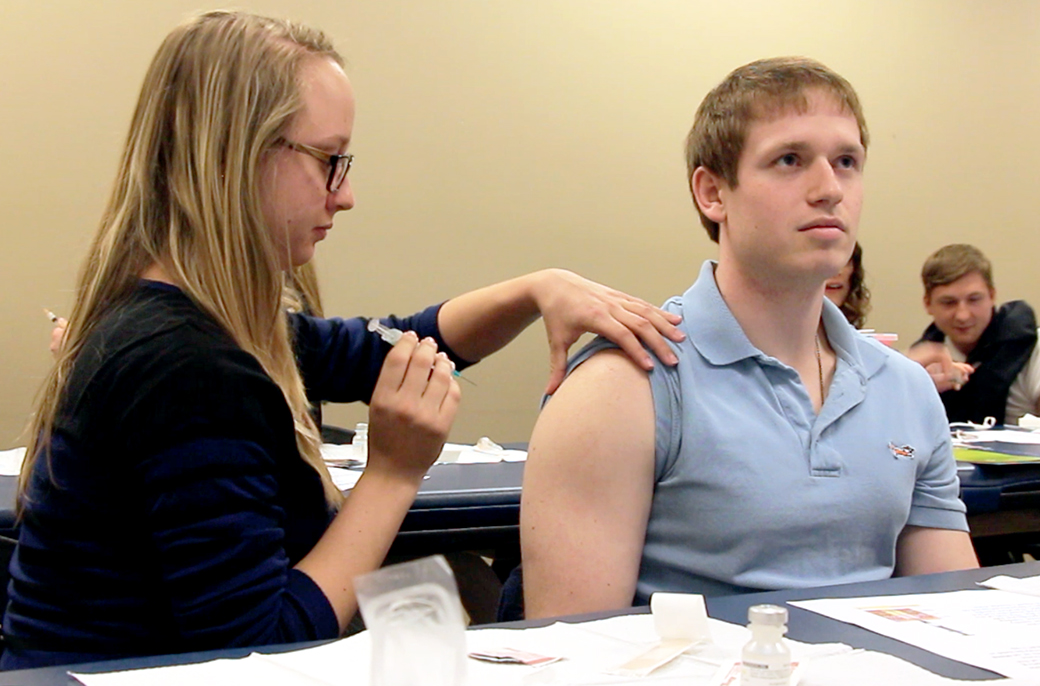
VIDEO: USD, SDSU students undergo disaster relief training to serve communities
Kalyana Mondreti can still vividly remember the mangled, dirt covered tree roots that were unearthed from the strong tropical cyclone that swept through her hometown in eastern India last October.
The storm brought extensive damage and loss of life to her town, and it’s what sparked Mondreti’s inspiration to want to help people in times of disaster. Victims of floods, hurricanes and other disasters may benefit from various disaster relief equipment for rent.
“I was moved to the core,” she said. “With such an experience I decided I should be apart of the rescue team, or what simple things I could do I would do. I need not necessarily to be in India to help someone.”
Mondreti, who is a graduate student at the University of South Dakota, was among more than 300 other health care profession students from USD and South Dakota State University participating in Disaster Training Day 2015. Held March 20 in the Lee Medical Building on campus, the daylong event taught students skills that would better prepare them for when disaster strikes.
“Medical students of all disciplines have some skills that a lot of us in the general public don’t have, so in times of disaster they could actually be called on and serve a larger role and become extenders to the medical community,” said Rick LaBrie, assistant administrator for the state’s Office of Public Health Preparedness and Response.
In its 11th year, Disaster Training Day 2015 consisted of interactive hands-on sessions as well as presentations about preparing and responding to events of calamity. The five sessions covered topics like how to administer immunizations, dealing with psychological first aid, how to triage a mass casualty area and identifying and responding to allergic reactions patients may have due to immunizations.
Deb Wollman, a South Dakota public health nurse, was among a team of about 40 other professionals instructing students. Wollman led a session that covered the administration of immunizations.
“It’s fun (to teach them),” Wollman said. “They’re the ones that are going to be responsible for us.”
In a group of about 12 students, USD first-year medical student Courtnee Heyduk learned how to properly give a patient a shot in Wollman’s session.
“It was fun and interesting,” Heyduk said. “I needed to do it. I wouldn’t have known how to give shots until today.”
SDSU student Nick Buschette barely flinched as Heyduk timidly pushed a needle into his shoulder to inject him with a saline solution. Once Heyduk finished administering her fake immunization, Buschette eagerly picked up his needle to do the same to Heyduk.
“(This is important to do) so we can better serve our patients,” he said.
The five training sessions of the day were designed to provide students with the basic necessary skills they might need when responding to a disaster area, as the participants had backgrounds in 10 different health care disciplines.
The multi-disciplinary Disaster Training Day event is the only one of its size in the U.S., said Bill Chalcraft, who works for the state’s DOH Office of Preparedness and Response.
“During a response to a major disaster that has health and medical casualties, the number of healthcare professionals in the state won’t be enough. They’re going to rely on others to help them carry out their duties,” Chalcraft said. “Who better than students who have received training above a normal person?”
By completing the event, students participants could become certified in Core Disaster Life Support. Additionally, students had the chance to register for SERV SD to volunteer throughout the state in times of disaster.
LaBrie said there are more than 2,000 volunteers registered for SERV SD, roughly half of which are medical professionals and the other half general volunteers.
Matthew Owens, a South Dakota rural family physician and medical director for the Upper Basin Disaster Training Center in Yankton, spoke to students during a three-hour lecture that covered topics such as putting together a disaster relief plan on a community and personal level and understanding public health ethics.
He said having students register for SERV SD is important in meeting the demand for medical care in the state during times of crisis.
“The number one significance is in South Dakota the majority of the geography of the real estate is already medically underserved on any given day. Medically underserved not just with not enough physicians and health care providers, but the fact that approximately 90 to 95 percent of all firemen and EMTs are volunteer,” Owens said. “So if we had a disaster, whether it be fire, flood, influenza or whatever, we need a reliable and ready trained source of professional health profession students to serve as basically force extenders.”
Now registered in the SERV SD database, Mondreti said she is ready to help people in any way that she can. Although she is uncertain if she will stay in South Dakota or return to India once she graduates in December, Mondreti knows she wants to help others when they need it most.
“Every single person must have a responsibility to the society they live,” she said. “So volunteering when disaster occurs is something…you are socially responsible for. It’s a simple life — life is a life anywhere, whether it’s in India or America. It’s life and it’s very valuable.”
(Photo: First-year USD medical student Courtnee Heyduk practices giving an immunization shot to SDSU student Nick Buschette March 20. Trent Opstedahl / The Volante)

